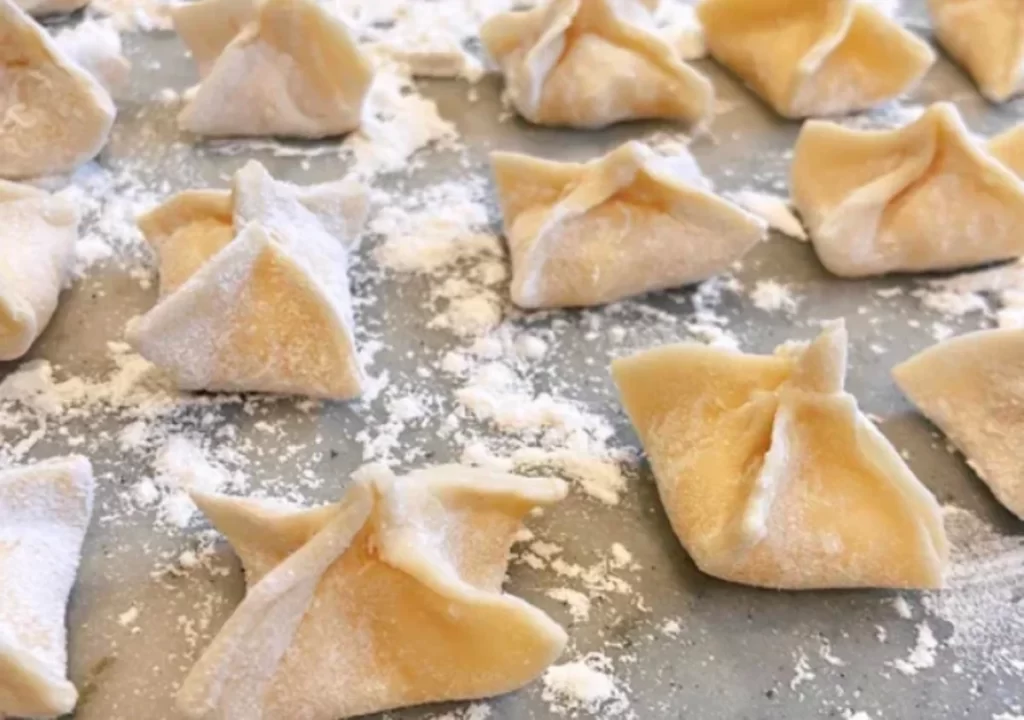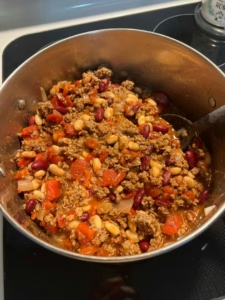Ever heard of Sacchetti Pasta? It’s a special pasta from Italy that many haven’t tried yet. In this article, you’ll learn why it’s so loved and get the best recipe to try at home!

The first time I had Sacchetti pasta, it felt special. It’s not just about the taste or how it looks. It’s the feeling and memories it brings. If you haven’t tried it, you’re in for a nice surprise. Let’s explore this tasty pasta together.
Discovering Sacchetti: The Pasta You’ve Missed Out On
The Origin of Sacchetti Pasta:
The Italian Roots
Like many great pastas, Sacchetti comes from Italy. People think it started in the northern regions, where they often eat fresh pasta and stuffed treats.
What gives Sacchetti its name?
The name “Sacchetti” comes from the Italian word “sacchetto,” which means “little bag” or “pouch” in English. The pasta looks like small pouches or bags, just like its name suggests. Each piece of this pasta holds many delicious flavors inside.
What is sacchettini pasta?
“Sacchettini” pasta is a diminutive form of “Sacchetti” pasta. The name “Sacchettini” translates to “little small bags” or “tiny pouches” in English, emphasizing its petite size.
Like Sacchetti, Sacchettini has a shape similar to small pouches or bags. Makers typically fill these tiny pasta pockets with different ingredients, from cheeses and meats to also vegetables. The pasta’s design, indeed, makes sure that each piece holds a burst of flavor from what’s inside.
Because Sacchettini is small, it’s great for soups or as a starter in many meals. In fact, its special shape and size make it fun to eat, and many people who love pasta really like it.
Diving Deep into Italy’s Pasta Secrets
How Do Italians Really Eat Sacchetti?
Sacchetti, like many other pasta varieties, holds a special place in Italian cuisine. Here’s how Italians traditionally enjoy this delightful pasta:
- Simplicity is Key: Italians believe in letting the ingredients shine. When it comes to Sacchetti, the fillings are the star. They often use a mix of cheeses, meats, or vegetables and also season them lightly to highlight their natural taste.
- Sauce Matters: While Sacchetti can be paired with a variety of sauces, Italians often prefer lighter sauces that don’t overpower the delicate fillings. They often choose a basic butter and sage sauce or a fresh tomato sauce for this pasta.
- Cooked to Perfection: Italians prefer their pasta al dente, which means Sacchetti should feel soft with a slight bite.
- Meal Placement: In a traditional Italian meal, Sacchetti pasta serves as a “primo” or first course. It follows the appetizers and precedes the main dish.
- Accompaniments: While the pasta itself is the main attraction, Italians often enjoy it with sides like fresh bread or a crisp salad.
- Enjoyed with Wine: A meal in Italy often includes wine. Depending on the fillings and sauce of the Sacchettini, Italians might opt for a white or red wine to enhance the dining experience.
Cheese on Pasta: Fact or Fiction?
When diving into the world of Italian cuisine, especially pasta, one question often arises: Should we sprinkle cheese on our pasta? Let’s simplify this.
The Tradition: In Italy, adding cheese to pasta depends on the dish and its sauce. Not all pastas get a cheese sprinkle. The choice often ties to regional specialties.
Sacchetti & Cheese: Sacchetti, with its rich fillings, might seem complete without cheese. But a mild filling can shine with a cheese touch. Balance is key.
Sauce & Cheese: Got a creamy pasta sauce? Maybe skip the extra cheese. But a light sauce can benefit from it. Curious about making a creamy cheese sauce? Discover the best melting cheeses and try this homemade cheese sauce recipe.
The Cheese Debate: Some say cheese masks pasta’s true flavors. Others feel it enhances. It’s a personal choice.
Top 5 Cheeses For Your Sacchetti Pasta:
Ricotta Cheese and Sacchetti Pasta
Taste: Ricotta is creamy and slightly sweet. It’s a soft cheese that feels smooth on your tongue.
Why Ricotta for Sacchetti?: Ricotta’s gentle flavor goes well with Sacchetti. It doesn’t hide the taste of the pasta’s filling but adds a nice creamy touch to it. Whether your Sacchetti has meat or veggies inside, Ricotta fits right in.
Parmesan: Bold Flavor for Your Pasta
Taste: Parmesan is nutty and savory. It has a strong flavor that lingers in your mouth.
Why Parmesan for Sacchetti?: The bold taste of Parmesan adds depth to Sacchettini. When you sprinkle it on top, it gives a crunchy texture and a rich flavor boost. It’s especially good if you want to add a bit of zest to a simple Sacchettini dish.
Mozzarella: Pure Melty Goodness
Taste: Mozzarella is soft and milky. It has a mild and creamy flavor that melts easily.
Why Mozzarella for Sacchetti?: Mozzarella’s gentle taste and melt-in-your-mouth texture make it a great choice for Sacchetti. When heated, it becomes stretchy and gooey, adding a delightful creaminess to the pasta. It’s perfect for those who love a smooth and cheesy touch to their Sacchettini.
Gorgonzola: A Tangy Surprise
Taste: Gorgonzola is tangy and sharp. It has a bold, blue-veined flavor with a hint of spice.
Why Gorgonzola for Sacchetti?: The strong taste of Gorgonzola can give Sacchetti an exciting twist. In fact, it adds a punch of flavor, making the pasta richer and more robust. Also, if you’re looking to spice up your Sacchetti pasta and enjoy intense cheese flavors, Gorgonzola is a top pick.
Fontina Cheese: Rich and Luxurious Pasta Addition
Taste: Fontina is smooth and slightly nutty. It has a mild, buttery flavor that melts well.
Why Fontina for Sacchetti Pasta?: Fontina has a smooth, melt-in-your-mouth texture that pairs perfectly with Sacchetti. Its mild flavor boosts the pasta’s filling without taking over. So, if you’re looking for a cheese that adds just the right touch of creaminess and depth, Fontina is the way to go.
Making Sacchetti Pasta: The Ultimate Guide
Ready to dive into the world of Sacchetti pasta? Let’s get started!

1. Choose Fresh Ingredients: Start with fresh ingredients. Fresh flour, eggs, and fillings make a big difference. Remember, better ingredients mean tastier Sacchetti.
2. Roll Evenly: When rolling out your pasta dough, aim for an even thickness. This ensures your Sacchetti cooks at the same rate and has a consistent texture.
3. Don’t Overfill: It’s tempting to stuff in a lot of filling, but less is more. Overfilling can cause the pasta to burst when cooking. A small spoonful is usually enough.
4. Seal Tight: Press the edges of your Sacchetti firmly. This keeps the filling inside and gives that perfect pouch shape.
5. Boil Gently: When it’s time to cook, use a big pot of boiling water. Add some salt. Gently drop in the Sacchetti. Don’t overcrowd the pot. Stir softly to prevent sticking.
6. Watch the Time: Sacchetti doesn’t take long to cook. Once they float to the top, give them another minute or two. Then, they’re ready!
7. Pair with Simplicity: A simple sauce works best. Think light tomato or butter and sage. Let the Sacchetti be the star.
Perfect Sauce Pairings for Sacchetti Pasta
Sacchetti pasta is a delight on its own, but the right sauce can elevate it to a whole new level. Here are top 6 sauce choices to make your sacchetti pasta truly shine:

1. Butter and Sage: First off, this light sauce is a big hit with sacchetti pasta fans. When you mix melted butter with sage, it really brings out the pasta’s taste. So, every bite is just delicious.
2. Tomato Basil: Craving a fresh and tangy touch with your sacchetti pasta? Look no further. Opting for a homemade marinara sauce is the ideal choice. Not only is it delicious, but its vibrant flavors also seamlessly complement any filling you choose.
3. Creamy Alfredo: If you’re someone who naturally gravitates towards luscious, creamy textures, then you’ll find that an Alfredo sauce pairs seamlessly with sacchetti pasta. Not only does it complement the pasta beautifully, but it also offers a rich and velvety treat.
4. Pesto: Looking for a fresh twist? A pesto sauce, especially when it’s a Mafaldine pasta with zesty pea shoot Meyer lemon pesto, offers a delightful nutty and fresh flavor that pairs beautifully with sacchetti.
5. Mushroom and Truffle Oil: For a gourmet touch, why not try sacchetti pasta with a mushroom sauce? This pasta with mushrooms and peas recipe can also be a great starting point. The truffle oil adds an extra layer of richness.
6. Roasted Red Pepper: Add a splash of color and also sweetness to your sacchetti pasta with a roasted red pepper sauce. It’s a delightful combination that never fails to impress.
How do you pronounce Sacchetti pasta?
“Sacchetti” pasta is pronounced as “sah-KEH-tee.” The “cc” in Italian is pronounced like the “k” in English when followed by the vowels “e” or “i.” So, you emphasize the “KEH” part in the middle. It’s a smooth and flowing pronunciation, much like many Italian words.
The Best Sacchetti Recipe You Can’t Miss Out On!
Sacchetti, which means ‘little bags’ in Italian, are more than just pasta. First, you get the soft pouch, and then, inside, there’s a tasty surprise filling. So, if you’re thinking of trying something new, here’s a must-try recipe that will make your taste buds dance with joy!
Ingredients:
- Fresh pasta dough (store-bought or homemade)
- 1 cup of ricotta cheese
- 1/2 cup of grated Parmesan cheese
- 1/4 cup of chopped fresh basil
- 1/4 cup of chopped sun-dried tomatoes
- Salt and pepper to taste
- 1 egg (for egg wash)
- Your favorite pasta sauce (like marinara or Alfredo)
How to make Sacchetti Pasta:
- Prepare the Filling:
- Firstly, in a mixing bowl, combine ricotta, Parmesan, basil, and sun-dried tomatoes. Then, mix well until everything is blended. Season with salt and pepper.
- Roll the Pasta:
- Moreover, roll out your pasta dough thinly. Using a round cutter or a glass, cut out circles from the dough.
- Fill the Sacchetti:
- Firstly, place a small spoonful of the cheese mixture in the center of each pasta circle.
- Then, brush the edges of the circle with a bit of egg wash (a beaten egg with a splash of water).
- Finally, gather the edges of the pasta circle and pinch them together at the top, forming a little pouch.
- Cook the Sacchetti:
- Firstly, bring a large pot of salted water to boil.
- Once boiling, gently drop the sacchetti into the water. Let them cook for 3-4 minutes or until you notice they float to the top.
- After that, remove them using a slotted spoon and ensure they’re well-drained.
- Serve:
- Firstly, warm up your favorite pasta sauce in a pan.
- Then, add the cooked sacchetti to the sauce, gently tossing to ensure they’re evenly coated.
- Once cooked, serve the sacchetti hot. Additionally, garnish with some extra grated Parmesan and, for a touch of freshness, sprinkle on some fresh basil.
FAQs: Answering the Top 5 Questions about Sacchetti Pasta
- What does “Sacchetti” mean in English?
- In Italian, “Sacchetti” directly translates to “little bags” or “pouches.” Consequently, this name aptly describes the pasta’s distinct shape. Specifically, its design is tailored to encapsulate and hold delicious fillings.
- Is Sacchetti the same as Tortellini or Ravioli?
- While all three are stuffed pastas, they differ in shape and size. Tortellini are small and ring-shaped, often with a meat filling. Ravioli are square or round with various fillings. Sacchetti, on the other hand, resemble little pouches and can be filled with a range of ingredients.
- What fillings go best with Sacchetti?
- Sacchetti is versatile! Common fillings include cheeses like ricotta or mozzarella, vegetables, meats, or also seafood. The choice of filling often depends on the sauce you plan to pair it with.
- How do I store leftover Sacchetti?
- If uncooked, you can freeze sacchetti on a tray and then transfer them to a freezer bag. They can be cooked straight from frozen. If they’re already cooked, store them in an airtight container in the fridge for up to two days.
- Can I make Sacchetti with gluten-free ingredients?
- Absolutely! You can use gluten-free flour blends available in stores to make the pasta dough. Ensure that the fillings and sauces are also gluten-free.






